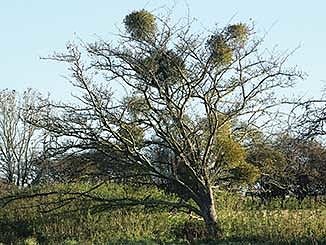Sussex Wildlife Trust: Mistletoe.
December 2nd, 2018 It’s certainly easy to see why mistletoe could appear to hold mystical qualities. As autumn strips a tree back to its bark bones it reveals an evergreen mistletoe heart; a beacon of life in the dead of winter.
It’s certainly easy to see why mistletoe could appear to hold mystical qualities. As autumn strips a tree back to its bark bones it reveals an evergreen mistletoe heart; a beacon of life in the dead of winter.Mistletoe – helping shy people snog since 1817
Christmas Eve 1989. After months of completely misreading the direction in which our friendship was going, I made an ill-informed attempt to snog Anna, from accounts, under the mistletoe at the work’s Christmas party. It was all a bit embarrassing but, in my defence, I was just doing my bit to uphold what has been described as 'the last surviving remnant of plant magic in the sophisticated western world’.
There are other plants which could claim similar magic powers. Half a bottle of fermented French grapes or a tumbler of Scottish malted barley will conjure up enough Dutch courage for some botanically inspired Christmas smooching. But what special power compels us to kiss under the mistletoe?
It’s certainly easy to see why mistletoe could appear to hold mystical qualities. As autumn strips a tree back to its bark bones it reveals an evergreen mistletoe heart; a beacon of life in the dead of winter. This apparent immortality inspired many ancient fertility rituals. Druids, armed with gleaming golden sickles, would perform a mistletoe harvesting ceremony under a waxing moon (and maybe slaughter two white bulls for good measure).
The plant’s secret to eternal life is that it is a hemi-parasite, obtaining its water and nutrients by vampirically sucking them from its host tree. It still has the decency to do a bit of photosynthesis itself (so it’s not 100% evil). In fact, research has proved that mistletoe is an ecological keystone species. Without it, there just isn’t as much life in a woodland.
The practice of hanging mistletoe at Christmas didn’t turn up in a written document until the 1600s and mention of lips meeting underneath it didn’t appear in print until 1817. Unsurprisingly, any ‘tradition’ involving kissing quickly became popular and since then everyone from Norse Gods to Ancient Greeks, Gauls and Romans have been trying to claim that the first snog under the mistletoe was their idea.
In the wild Mistletoe plants look like bushy green pom-poms which have been tossed into a tree by an over-enthusiastic cheerleader. Birds feed on their juicy white berries, which appear to be as messy to eat as a treacle and melted mozzarella pizza. Gooey beaks have to be wiped on a nearby branch, allowing any seeds to stick and sprout someplace new. Either that, or the birds disperse the seed in the more traditional intestinal way.
This Christmas keep looking high in the treetops for mistletoe, I haven’t seen any yet as I walk around Sussex – but I’ve seen plenty of proof that it’s still working its ancient magic on the people down below.
By Michael Blencowe: Learning & Engagement Officer, Sussex Wildlife Trust.
Mistletoe©Sue Curnock Sussex Wildlife Trust.
Christmas Eve 1989. After months of completely misreading the direction in which our friendship was going, I made an ill-informed attempt to snog Anna, from accounts, under the mistletoe at the work’s Christmas party. It was all a bit embarrassing but, in my defence, I was just doing my bit to uphold what has been described as 'the last surviving remnant of plant magic in the sophisticated western world’.
There are other plants which could claim similar magic powers. Half a bottle of fermented French grapes or a tumbler of Scottish malted barley will conjure up enough Dutch courage for some botanically inspired Christmas smooching. But what special power compels us to kiss under the mistletoe?
It’s certainly easy to see why mistletoe could appear to hold mystical qualities. As autumn strips a tree back to its bark bones it reveals an evergreen mistletoe heart; a beacon of life in the dead of winter. This apparent immortality inspired many ancient fertility rituals. Druids, armed with gleaming golden sickles, would perform a mistletoe harvesting ceremony under a waxing moon (and maybe slaughter two white bulls for good measure).
The plant’s secret to eternal life is that it is a hemi-parasite, obtaining its water and nutrients by vampirically sucking them from its host tree. It still has the decency to do a bit of photosynthesis itself (so it’s not 100% evil). In fact, research has proved that mistletoe is an ecological keystone species. Without it, there just isn’t as much life in a woodland.
The practice of hanging mistletoe at Christmas didn’t turn up in a written document until the 1600s and mention of lips meeting underneath it didn’t appear in print until 1817. Unsurprisingly, any ‘tradition’ involving kissing quickly became popular and since then everyone from Norse Gods to Ancient Greeks, Gauls and Romans have been trying to claim that the first snog under the mistletoe was their idea.
In the wild Mistletoe plants look like bushy green pom-poms which have been tossed into a tree by an over-enthusiastic cheerleader. Birds feed on their juicy white berries, which appear to be as messy to eat as a treacle and melted mozzarella pizza. Gooey beaks have to be wiped on a nearby branch, allowing any seeds to stick and sprout someplace new. Either that, or the birds disperse the seed in the more traditional intestinal way.
This Christmas keep looking high in the treetops for mistletoe, I haven’t seen any yet as I walk around Sussex – but I’ve seen plenty of proof that it’s still working its ancient magic on the people down below.
By Michael Blencowe: Learning & Engagement Officer, Sussex Wildlife Trust.
Mistletoe©Sue Curnock Sussex Wildlife Trust.
Comments (0)
No comments have been submitted yet.Why not be the first to send us your thoughts
Leave A Comment
Thank you for your comments, they will appear shortly once approved.
Recent Posts
Have You Seen...






